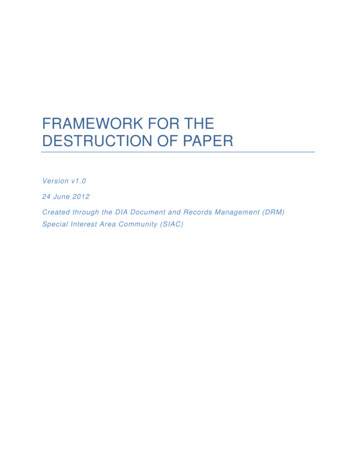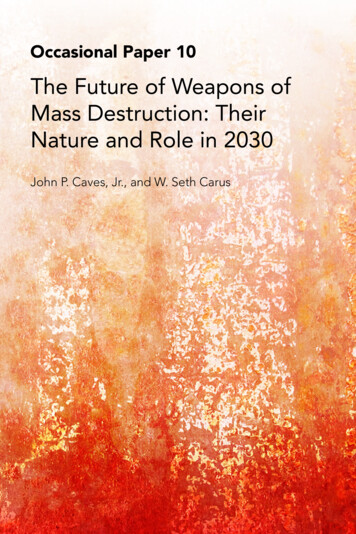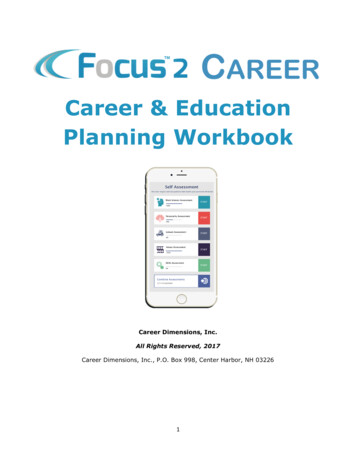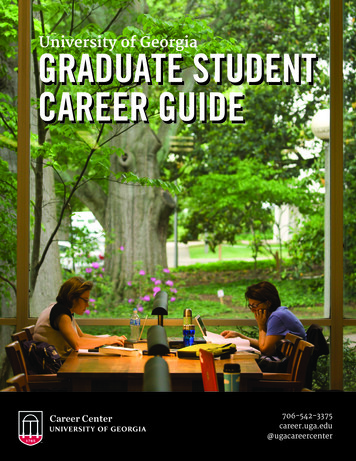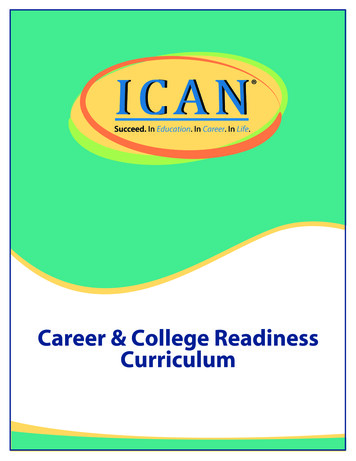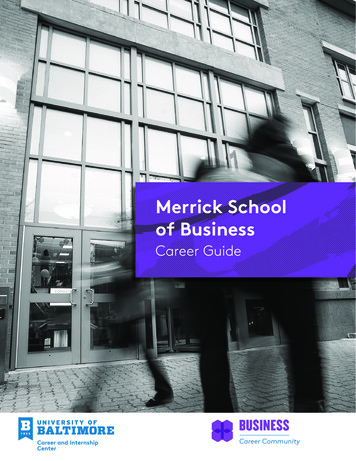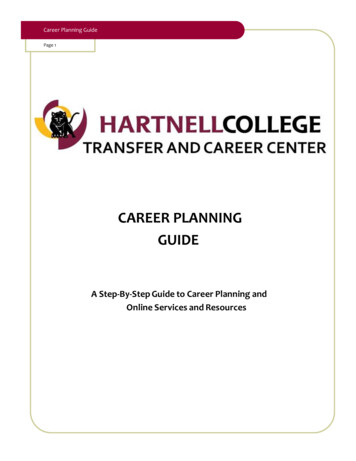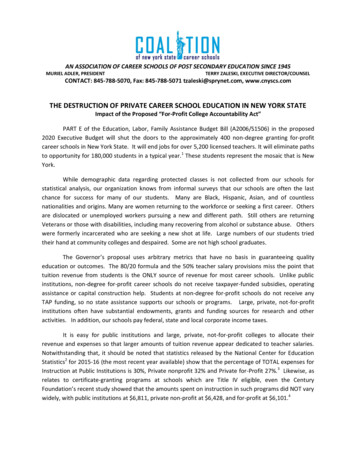
Transcription
AN ASSOCIATION OF CAREER SCHOOLS OF POST SECONDARY EDUCATION SINCE 1945MURIEL ADLER, PRESIDENTTERRY ZALESKI, EXECUTIVE DIRECTOR/COUNSELCONTACT: 845-788-5070, Fax: 845-788-5071 tzaleski@sprynet.com, www.cnyscs.comTHE DESTRUCTION OF PRIVATE CAREER SCHOOL EDUCATION IN NEW YORK STATEImpact of the Proposed “For-Profit College Accountability Act”PART E of the Education, Labor, Family Assistance Budget Bill (A2006/S1506) in the proposed2020 Executive Budget will shut the doors to the approximately 400 non-degree granting for-profitcareer schools in New York State. It will end jobs for over 5,200 licensed teachers. It will eliminate pathsto opportunity for 180,000 students in a typical year.1 These students represent the mosaic that is NewYork.While demographic data regarding protected classes is not collected from our schools forstatistical analysis, our organization knows from informal surveys that our schools are often the lastchance for success for many of our students. Many are Black, Hispanic, Asian, and of countlessnationalities and origins. Many are women returning to the workforce or seeking a first career. Othersare dislocated or unemployed workers pursuing a new and different path. Still others are returningVeterans or those with disabilities, including many recovering from alcohol or substance abuse. Otherswere formerly incarcerated who are seeking a new shot at life. Large numbers of our students triedtheir hand at community colleges and despaired. Some are not high school graduates.The Governor’s proposal uses arbitrary metrics that have no basis in guaranteeing qualityeducation or outcomes. The 80/20 formula and the 50% teacher salary provisions miss the point thattuition revenue from students is the ONLY source of revenue for most career schools. Unlike publicinstitutions, non-degree for-profit career schools do not receive taxpayer-funded subsidies, operatingassistance or capital construction help. Students at non-degree for-profit schools do not receive anyTAP funding, so no state assistance supports our schools or programs. Large, private, not-for-profitinstitutions often have substantial endowments, grants and funding sources for research and otheractivities. In addition, our schools pay federal, state and local corporate income taxes.It is easy for public institutions and large, private, not-for-profit colleges to allocate theirrevenue and expenses so that larger amounts of tuition revenue appear dedicated to teacher salaries.Notwithstanding that, it should be noted that statistics released by the National Center for EducationStatistics2 for 2015-16 (the most recent year available) show that the percentage of TOTAL expenses forInstruction at Public Institutions is 30%, Private nonprofit 32% and Private for-Profit 27%.3 Likewise, asrelates to certificate-granting programs at schools which are Title IV eligible, even the CenturyFoundation’s recent study showed that the amounts spent on instruction in such programs did NOT varywidely, with public institutions at 6,811, private non-profit at 6,428, and for-profit at 6,101.4
This proposal completely ignores the important impact of certificate-granting programs onproviding a skilled workforce in New York State. Table I suggests the unfilled job demand for severaloccupations and the percentage of for-profit private career schools completers. The table reveals thecritical role that for-profit career school capacity plays in fulfilling outstanding job demands. Where isthe capacity to provide this training otherwise?TABLE I - 2017 New York Job Demand and Completion Data in Selected Fields5Program Name:Total Completions:Job Openings:Unfilled Jobs:Culinary Arts1,744 (38% of completions from our sector)20,35018,606Program Name:Total Completions:Job Openings:Unfilled Jobs:Information Technology884 (9% of completions from our sector)13,47012,586Program Name:Total Completions:Job Openings:Unfilled Jobs:Cosmetology and Related Personal Grooming Services4,465 (95% of completions from our sector)9,0004,535**Note that this includes multiple programs including hair stylists, nail technicians, makeup artists andskincare specialists.Program Name:Total Completions:Job Openings:Unfilled Jobs:Graphic Design936 (36% of completions from our sector)4,8803,944Program Name:Total Completions:Job Openings:Unfilled Jobs:Automotive Mechanics Technician992 (57% of completions from our sector)3,8902,898Non-degree granting for-profit schools are governed by the New York State EducationDepartment’s (“SED”) Bureau of Proprietary School Supervision (“BPSS”) pursuant to comprehensivelegislation that was enacted in 1990.6 The legislative framework and enabling regulations have provideda robust and effective regulatory structure for New York’s non-degree granting for-profit career schools.Student protection is at the heart of the framework and the oversight of BPSS is rigorous. The New Yorkmodel is the most comprehensive and detailed system in the United States.2
To receive a BPSS career school license, every aspect of a school’s proposed operation is vetted.Curriculums and enrollment agreements must be approved. All teachers must satisfy special workexperience criteria and teaching methodology courses. Financial viability is judged by SED accountants.BPSS inspects all proposed classroom and administrative space, and it even specifies the number ofstudents that can be in each class for a particular program. Admissions representatives are licensed,incentive compensation is prohibited, and schools have well-defined student service and job placementprocedures. Annual certified financial audits must be filed before July 1 for the preceding fiscal year.Periodic license renewals are required for curriculums, teachers, admissions counselors, and directors,along with school relicensing as well.The budget for BPSS oversight and monitoring of the schools is provided by the schoolsthemselves. The statute requires that one-half percent of all GROSS ANNUAL TUITION RECEIPTS (“GAT”)be remitted to the BPSS Supervisory Account, a special revenue account.In addition all schools have remitted substantial funds into a Tuition Reimbursement Accountdesigned to make a student whole if it can demonstrate that the school violated any standard oroperating procedure. The TRA assessment is as much as an additional one-half percent of GAT for anewly licensed school and, depending on the amount in the fund, all other schools might be required topay three-tenths of a percent. Usually, a viable school will reimburse the student directly after a BPSSdetermination, rather than drawing down the TRA. The TRA is a special protection in case a schoolcloses. BPSS can pursue collection of any amount that might be paid from the TRA.As the preceding recitation of BPSS oversight reveals, many parts of the revenue stream for NewYork’s non-degree granting for-profit institutions are determined by the state. The number of studentsper class, the number of classrooms, the nature and format of curriculum, and the quartersrequirements all of these are set by the state. Even the cost of a program and the method of paymentmust all be spelled out in a state-approved enrollment agreement. Specific refund policies keyed todates of withdrawal are required to be expressly stated on the enrollment agreement. Thiscomprehensive regulatory system means that a school has limited ability in how it shoulders itsoperational expenses. Unlike public or not-for profit private institutions, It cannot expand class size oradd more classrooms to try to mitigate fixed costs. There are no “survey” lecture classes at our schoolwith 200 students and one instructor! How do the faculty ratios compare for the public and private,not-for-profit institutions and us, especially if TA’s and graduate assistants were excluded? This wouldmake for some interesting research that suggests a major flaw with the reasoning of the Governor’sproposal.The salaries paid to teachers in non-degree granting for-profit institutions are determined bymarket forces. Licenses are held individually by each teacher. Teachers seek opportunities to fit theirpersonal career goals and expectations. They are not being exploited by the salary structures in place,but, on the contrary, those structures must be competitive in the marketplace.3
Fixed costs dominate most non-degree granting career schools – rent, insurance, build-out andmaintenance of physical space, equipment, information technology, accounting, administration,compliance, licensing costs, and the surcharges paid BPSS for monitoring and the TRA. The vast majorityof all these schools will be shuttered by the 50% teacher salary proposal.The Governor’s proposal runs 180 degrees counter to the renewed emphasis on careereducation espoused by the New York Board of Regents and extant in the entire United States. Morepathways to career success should be encouraged. The “one-size, fits all” college degree is no longerregarded as society’s standard of achievement. The State Education Department has been expanding itsemphasis on Career and Technical Education (“CTE”) and has even pioneered a high school graduationpathway that allows substitution of a Career Development and Occupational Studies (“CDOS”) credentialfor a Regents exam.Non-degree granting for-profit schools have been sought after by public schools to providetraining to public school students while still in high school. Our schools are saving public school districtsthe expense of capital outlay and operational costs. This proposal threatens the existence of thoseschools.A number of schools in our sector have successfully dedicated much of their mission to servingstudents with disabilities who are recommended for placement by vocational rehabilitation counselorsthrough SED’s ACCES-VR (Adult Career and Continuing Education Services- Vocational Rehabilitation)services. This proposal threatens the existence of those schools.Other schools in our sector provide unique training that is indispensable in the New Yorkmetropolitan area -- welding, high pressure boiler maintenance, HVAC, and stationary engineer schools– this proposal threatens the existence of those schools.The need for entry-level support staff at hospitals, doctor’s offices, dental offices, nursinghomes, hospices, and home care is staggering. This proposal threatens the very existence of the schoolsthat train for those careers.Our schools have long provided the vast majority of trained and licensed cosmetologists,estheticians, and barbers throughout New York State. This proposal threatens the existence of thoseschools.New York City, home to so much of the performing arts, depends on several non-degreegranting for-profit career schools. This proposal threatens the existence of those schools.The 180,000 men and women who choose to attend New York’s licensed career schools arereceiving an education that has been crafted to meet exacting state standards and fulfill occupationalgoals. Our schools only exist to the extent that they succeed at getting students to complete theirtraining, graduate and be launched onto a chosen career path. Most of the programs of study at our4
career schools are less than one year. There is real value in the certificate or diploma that the studentreceives.The Governor’s “For-Profit College Accountability Act” does nothing for accountability of ourschools. That is already being provided by the BPSS licensing, monitoring and enforcement mechanisms.They work. BPSS has already addressed the issue of arbitration agreements as well. The only impact ofthis wrong-headed proposal would be the complete and utter destruction of our schools. The hundredsof thousands that might otherwise benefit from career opportunity will be denied their chance. Neitherthe Assembly nor Senate could countenance this result. This proposal must be discarded in its entirety.No portion of it should be approved.1FY 2020 Executive Budget Briefing Book, p. 97.2The National Center for Education Statistics (NCES) is the primary federal entity for collecting and analyzing datarelated to education in the U.S. and other nations. NCES is located within the U.S. Department of Education andthe Institute of Education Sciences. NCES fulfills a Congressional mandate to collect, collate, analyze, and reportcomplete statistics on the condition of American education; conduct and publish reports; and review and report oneducation activities play.asp?id 754“Grading New York Colleges,” The Century Foundation, Table 4 (2018)5Total Completions pulled from Department of Education IPEDS using 2017-18 provisional release data. JobDemand found using Projection Central Short Term Occupational Projections (2017-2019) Average AnnualOpenings.6Chapter 887 of the Laws of 1990, Proprietary School Reform Act, (A.7517-D(Brodsky)), subsequently designatedas Article 101 of the Education Law, Sections 5001-5010.5
THE DESTRUCTION OF PRIVATE CAREER SCHOOL EDUCATION IN NEW YORK STATE Impact of the Proposed "For-Profit College Accountability Act" PART E of the Education, Labor, Family Assistance Budget Bill (A2006/S1506) in the proposed . Cosmetology and Related Personal Grooming Services Total Completions: 4,465 (95% of completions from our sector .


